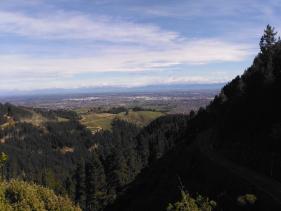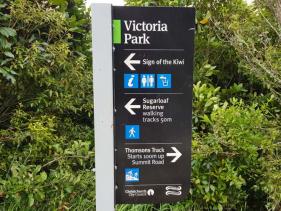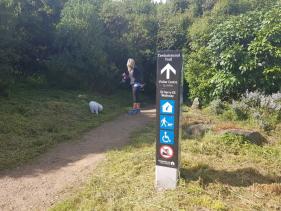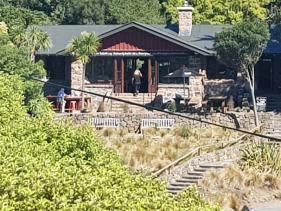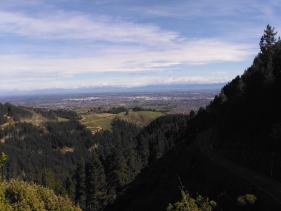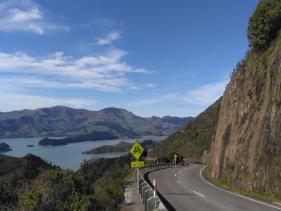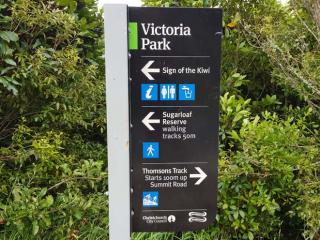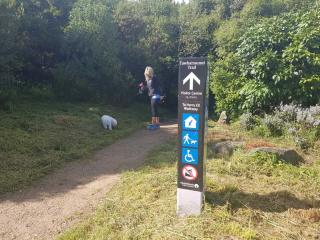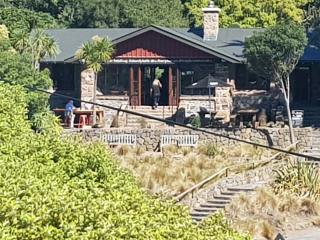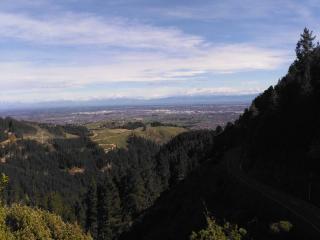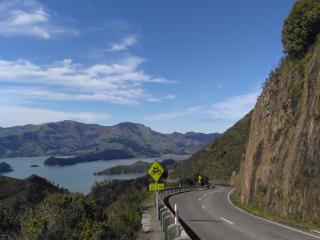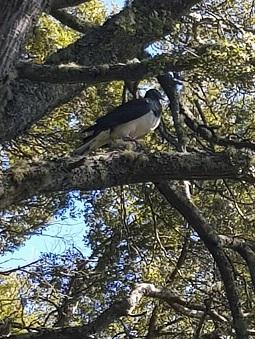
Doing the full experience
- Start: Sign of the Takahe. the first part takes you up a pathway with a bit of a gradient so if your new to walking and want it a little easier join the walk up the road a little further by the dog park carpark.
- Finish: Sign of the Kiwi. Well worth stopping here for a scone and something to drink "The Sign of the Kiwi Cafe & Bar".
- Distance: 3 km. one way if you start from the Sign of the Takahe.
- Time: 45 minutes one way average speed walking or fast walk 30 minutes people run up the track as well.
- Toilets: Located at Victoria Park and Sign of the Kiwi.
- Dogs: Are welcome but must be kept on a leash "don’t forget your poo bag".
Harry Ell track on the Christchurch port hills would be one of my personal favourite walks to do and I never tire of walking it. As it can be started from a variety places and takes you through different scenery from open areas with views of the city to bush with native birds.
There are areas to stop and rest or take in the views either from platforms or seats a great deal of work has gone into the track to make it as accessible as possible.
Half way up there is a water fountain including water for dogs and facilities are located in Victoria Park just off the track next to the dog park.
Facilities are also at the top of the track next to the Sign of the Kiwi Cafe.
Some parts of the track can be uneven with other sections being graded almost flat, it's mostly an undulating track that takes you up to the Summit road which leads to Victoria Park. Harry Ell runs close to Dyers Pass road, although for most of the walk you won't be able to see the road itself.
Since the Port Hills fires in 2017 there has been some replanting to rejuvenate the bush that was devastated by the fire.
In areas where there are no trees the view of the city and the Southern Alp's on a good clear day is spectacular. You will also be able to see the Christchurch Adventure Park that operates close by which has off-roard Bike Tracks, Zip Line and Chair Lift.
One of the good things about the track is the number of alternative options you can take as there are different branches that take you away and back to Harry Ell itself. Not to worry although a little confusing you won't get lost either head up or down a track and you will always get to the top or bottom whichever is your destination.
Suitable for all the family to enjoy including the dog!
The Harry Ell Legacy
An enthusiastic naturalist and visionary, Harry Ell worked tirelessly to develop reserves and ensure their preservation in the face of expanding settlement.
Personal life
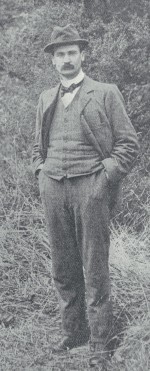 Harry Ell, 1904, Christchurch City Libraries
Harry Ell, 1904, Christchurch City LibrariesHenry George Ell was born on a farm in Halswell, Christchurch, in 1862 and spent much of his youth exploring Kennedy's Bush. After leaving school at the age of 15 Harry worked in a variety of roles ranging from museum attendant to printer at the Christchurch Press. From 1884 Harry became involved in politics. He served as Member of Parliament from 1899 to 1919 and as a Christchurch City Councillor. His concern for the diminishing native bush in New Zealand set him on a course that would lead to the foundation of New Zealand's first scenic reserves.
Summit Road scheme
Energetic and tenacious, Harry Ell was known in the political arena for his radical policy proposals and was a champion for not only the environment but for dental nurses in schools, pensions and mental health awareness. Already having played a significant role in stopping the closure of a number of Port Hills tracks in 1900 and in the passing of the Scenery Preservation Bill in 1903, his interest in New Zealand's natural heritage, plants and ecology eventually lead to the vision of a Summit Road to connect tracks and reserves between Christchurch and Akaroa.
Twenty hectares (49 acres) of Kennedy's Bush became New Zealand's first scenic reserve in 1906 and by the early 1930s a series of reserves in the Port Hills totalling over 200 hectares (500 acres) had been obtained through gifts and purchases. The Summit Road's construction began in 1908 in the hope that it would provide pedestrian and eventually vehicle access to the reserves and walking tracks in the Port Hills. Harry Ell was a major employer during the depression of the 1920s and 1930s with over 1000 men working on his Summit Road. The final section of the road to be completed was in 1938 between Dyers Pass Road and Evans Pass.
Rest houses
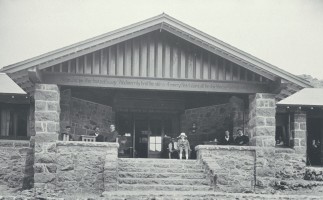
Sign of the Kiwi, ca.1920, Christchurch City Libraries
Intended to sit along the Summit Road, 14 rest houses were proposed to provide refreshments to those exploring the Port Hills scenic reserves. In the end, four were built: Sign of the Bellbird (1914), Sign of the Kiwi (1916), Sign of the Packhorse (1916 to 17) and Sign of the Takahe (1918 to 1948). The Sign of the Packhorse is managed by the Department of Conservation and is scheduled as a Highly Significant heritage item in the district plan.
Three of the rest houses, Bellbird, Kiwi and Packhorse, were designed by prominent architect Samuel Hurst Seager. All three were built from local stone and reflect the arts and crafts style in the way they blend with the natural landscape.
Sign of the Bellbird operated as a caretaker's cottage and tearoom and was even used as a post office and a telephone bureau for some time. Today, it provides welcome shelter to walkers. Sign of the Packhorse maintains its original use as a rest house and is currently managed as a historic tramping hut by the Department of Conservation. Sign of the Kiwi originally operated as a toll house and a tearoom and today is a popular cafe and information centre.
The fourth rest house, Sign of the Takahe, began construction in 1918 and was envisioned to be the finest of them all. The stunning two story Gothic-style building was designed by J G Collins to be a fitting entrance to the Summit Road scheme. Although the building wasn't completed until 1949, well after Harry's death, a section opened in 1920 and served as the Tram Terminus rest house and tearoom. In more recent years it has been a restaurant and function room and will return to that use once earthquake strengthening and repairs are completed.
Legacy
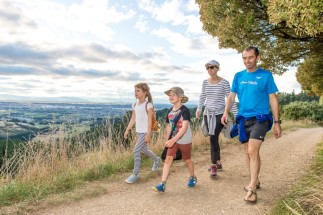
Harry Ell Walkway, Port Hills
The Summit Road has become the main access from Christchurch to the Port Hills. Since completion, Sunday afternoon drives and walks in the hills have become a major recreational pursuit for residents and visitors alike. In 1948 the modern Summit Road Society was founded by Harry Ell's grandson John Jameson and the Society's efforts continue to enhance, preserve and protect the nature, beauty and character of the Port Hills for future generations.
In November 2016, the spirit of Harry Ell's vision was honoured with the opening of Te Ara Pataka, or the Summit Walkway, by the Rod Donald Trust and the Department of Conservation. This 35-kilometre signposted track links Gebbies Pass in Lyttelton to Hilltop Tavern above Akaroa and takes two and a half days to complete.
Be sure to visit the Harry Ell Walkway in Victoria Park for a short walk encompassing stunning scenery and native plantings.
Harry Ell & The Summit Road
For the first European’s arriving in Lyttelton the Port Hills must have been a challenge that needed to be taken on. Keep in mind the new arrivals would have struggled with their possessions up the Bridle path from the port at Lyttelton.
Once they reach the summit, we can only assume the view they were meet with would have made the journey worthwhile.
On a good day the view across the Canterbury Plains, they would have looked on with wonder at the splendour of the Southern Alps, as range stretched as far as the eye could see.
As they glanced behind them the hills that shelter the calm waters and charming inlets of the Lyttelton basin parted here and there to disclose intriguing views of Lake Ellesmere and the broad Pacific beyond.
Harry George Ell will always be remembered as a great lover and driver of the Port Hills development. He is famous for his conservation work around Christchurch's Port Hills, his advocacy for the Summit Road, and his construction of the Sign of the Takahe and other road houses along the Summit Road.
Harry was born in Christchurch in 1862. He grew up on his parents’ farm in Halswell. From an early age, he became passionate about Christchurch’s natural heritage and its endangered species. It’s not hard to understand why his first job was at the Canterbury Museum.
Harry returned to his farming roots before becoming an armed constabulary at Taranaki, in the North Island. His participation in the destruction of Parihaka in 1881– a large Maori village would shape young Harry forever. He was completely dismayed with how the Maori people were treated and also witnessed the destruction of the native flora there. Still confused later in life, he wrote that his fellow soldiers actions,” brought about the bitterness and estrangement between two people”
On returning to Christchurch he became a printer for ‘The Press’ and for a time, a salesman. He became known for his energy and his dauntless approach to all his projects. Harry was elected as an Independent Liberal in the 1899 general election. He held the seat, and the subsequent seat of Christchurch South as an Independent, until the 1919.
During his political career, he was involved in the introduction of the old age pension and for schools -physical education, conservation studies and dental care. He also took part in the Temperance Movement and was firmly against the evils of gambling. He also successfully pushed for reform of New Zealand's mental health laws.
In 1892, Harry married Adelaide Eleanor Gee and the two went on to have 3 sons and 1 daughter.
Always interested in conservation and recreation, Harry’s greatest achievement was being a huge part of the Scenery Preservation Bill that was passed in government in 1903. In the face of an expanding settlement, Harry wanted Christchurch to keep its scenic beauty – especially the Port Hills.
Harry had visions of walkers and travellers enjoying a network of scenic reserves along the hills connected by a road with rest-houses along the way – right through to Akaroa.
I know the thought of walking to Akaroa is enough to make us 21st century people’s toes curl but it was not an unheard of thing. William Deans would walk to Akaroa from Riccarton to get mail in the 1840’s. Using the Maori trails etc., he would make it there within a day. With just under 20 rest-houses planned along what would start off as Summit Road, these would be places where people could stop and rest. only 4 of these buildings ended up being built.
Harry Ell was fascinated by these hills. He was a public-spirited man, and a lover of nature. In many ways he was ahead of his time as a conservationist determined to protect the remnants of the natural flora. In his dedication to preserve what was best, he had the brilliant idea of involving the public by ensuring that they had access to the whole area. Thus arose the exciting concept of a highway, together with walking tracks, along the summit of the Port Hills, and indeed extending right around the peninsula, with rest houses spaced at easy intervals.
When Harry’s political career came to an end in 1919, he poured his heart and soul into his Port Hills project. He faced financial strife as well as the doubts of many. He never let that bother him, he pushed forward, almost obsessed some said. The first area to be preserved was Kennedy’s Bush, the land above his father’s farm.
The foundation stone for the Sign of the Takahe was laid in 1918; it was to be tea-rooms for weary travellers. Its main purpose by the time it was finished however was a tram and bus terminus. In later years it did operate as a restaurant as well as serving High Tea’s on the weekends. It’s now a Function venue hired out by the Council, mostly for weddings etc. Although repaired after the earthquakes it’s currently not operating outside of private bookings.
By the 1930’s, the Port Hills section of the Summit Road was complete. A number of reserves were proposed from Godley Heads to Pigeon Bay. The Sign of the Kiwi, The Sign of the Bellbird and The Sign of the Packhorse were built, however Harry did not get to see the Sign of the Takahe finished as he died prior in1934. The place remained unfinished until the Christchurch City Council picked it up and it was finally opened in 1949.
Thanks to Harry, we have the Port Hills that we know and enjoy today. Walkways, scenic reserves and viewing areas that we can stop in and look out over our beautiful city.
Harry Ell is buried at St Mary’s Anglican Church in Halswell.
Recommended Read: Harry Ell of the Summit Road, a collection of thoughts by his grandson John Jameson, founder of the modern Summit Road Society in 1948
History information thanks to www.summitroadsociety.org.nz & www.peelingbackhistory.co.nz



